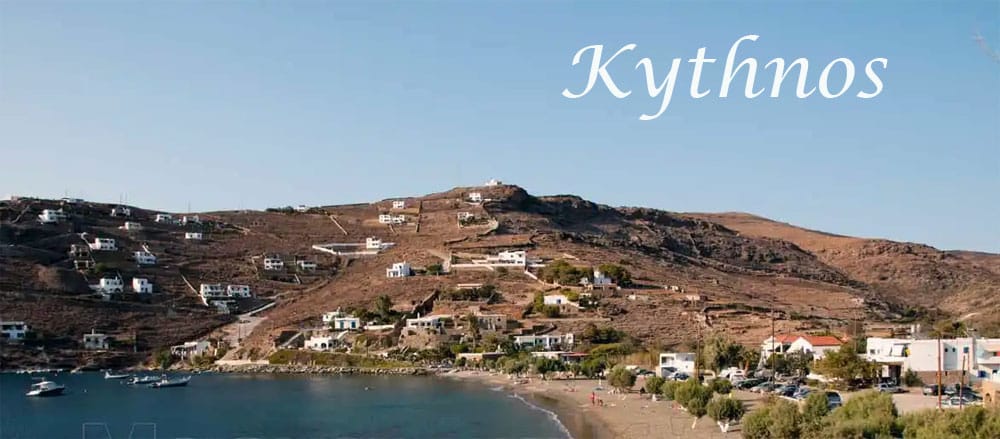Information about the island of Kythnos
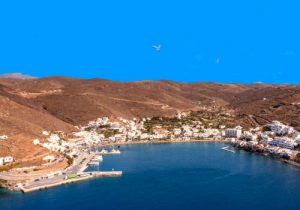
You certainly don’t come here for all night partying, swanky hotels and tourist beaches packed with tourists. But if you want a taste of the “real Greece “, untouched by mass tourism and uncrowded even at the height of the season then you’ve come to the right place.
The island attracts few foreign visitors but it’s popular with Athenian weekenders due to its lack of commercialisation and its proximity to the Greek capital. Daily ferry services connect the island with Piraeus (two and a half hours) and the neighbouring islands of Sifnos, Serifos, Kimolos and Milos. Flying Dolphins to and from the mainland take just an hour and a half.
Kythnos doesn’t offer the frantic tourist activity of the more popular islands such as Mykonos, Santorini and Ios. But it does offer traditional Cycladic villages where the locals are warm and hospitable (not having been worn down by international tourism), some lovely beaches (some only accessible by boat) and the famous thermal springs which have been providing alternative therapy for a variety of ailments for centuries.
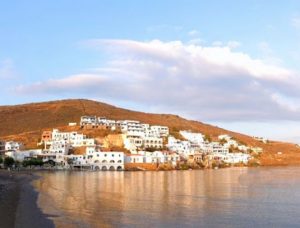
Dryopida was the island’s ancient capital in the Middle Ages and takes its name from the island’s pre-Hellenic inhabitants, the Dryopes whose king Kithnos is responsible for the island’s current name. A Mesolithic site in the north dates back to 7500-6000 BC and is the oldest settlement to have been uncovered in the whole of the Cyclades.
In 2002 Greek archaeologists made one of their most exciting finds of recent years when they discovered the unplundered inner sanctum of an ancient temple at Vryokastro in the west of the island. More than 1,500 priceless objects were found including 220 gold and silver items, 70 terracotta figurines and broken pottery adorned with images believed to be the work of master painters of ancient times.
Set off on foot, on a moped or in a 4×4 and you’ll discover a magical island of whitewashed houses, windmills, blue-domed churches, ancient sites and a way of life which seems hardly to have changed for centuries. There’s a stark beauty in the harsh mountainous terrain peppered with the figs, vines and goats which are important elements of the islanders’ livelihood.
Geography
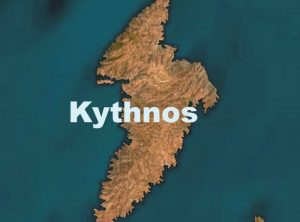
On the island there are two inland villages, Chora or Mesaria which is also the capital of the island and Dryopida. In addition there are three main seaside settlements: the main port of Merichas, Loutra with the thermal springs and Panagia Kanala with the church of the same name. This area of Kanala is one of the most popular summer destinations as many tourists vacation there. It is still famous as the “greenest” spot on the island.
Apart from them there are also several smaller settlements such as: Agios Dimitrios, Episkopi, Agios Stefanos, Flabouria, Kalo Livadi, Agia Irini and Apokrusi. On the left side of Mericha directly above the sea, rises the temple of Agios Akindynos. The Saints – Akindynos, Pigasios, Anebodistos, Elpidophoros and Afthonios – are the patrons of the port and its ships.
In the south-eastern part of the island is the village of Kanala, which takes its name from Panagia Kanala. The church of Panagia tis Kanala was built in 1869 on the site of the original church after the icon was found by local fishermen. Tradition says that the image was pulled up by fishermen’s nets in the strait (channel) between Kythnos and Serifos, hence the name Kanala.
History
The first inhabitants of Kythnos in ancient times are the Dryopes, whose mythical king is Kythnos (son of the god Apollo), hence the name of the island. It was also known as Dryopis or Ophiusa. During the Middle Ages it was called Thiramna, from 1143 it was mentioned under the name Thermia, from the hot springs that exist.
In ancient times a thriving Ionian colony had been established in Kythnos. The ancient Kythnians were also involved in shipping and participated in the Persian wars with a trireme and a pentakontor. The ancient state of Kythnos was famous for its prosperity, and for this reason Aristotle devotes a special study to Kythnos in his work “On the Kythnian State”, a work that has not survived. After the end of the Persian wars, Kythnos joined the Athenian Alliance, while it later came under the control of the Macedonians, who had established a garrison on the island.
During Roman rule, Kythnos was a place of exile for important persons. In addition, during antiquity, several temples functioned on the island, which resulted in the arrival of visitors to Kythnos from various regions (such as Egypt, Asia Minor, Italy, etc.). Also in ancient Kythnos, the painters Timanthi and Kydia were born.
Culture and tradition
Kythnos customs and culture is deeply rooted in its traditional practices. Music and dance play a significant role in the island’s festivities. Local feasts, known as “panigiria,” are a staple of Kythnian life. During these feasts, locals and visitors gather to celebrate saints’ days or other significant events, indulging in local delicacies, singing, and dancing to traditional tunes played on local instruments like the violin and lute.
The culinary heritage of Kythnos is another aspect of its rich culture. Kythnos cuisine features a variety of dishes made with locally sourced ingredients. Common staples include fresh seafood, goat meat, cheeses, and legumes. The island is also known for its unique pastries and sweets, often made with honey, almonds, and local spices.
Archaeological sites
The human presence on the island already dates back to the Mesolithic Times and excavations have shown that Kythnos was probably the oldest settlement in the Cyclades. Kythnos laid its own “foundation stone” in the Cycladic civilization, as it was the main supplier of copper, the basic metal for the manufacture of all kinds of tools, vessels and jewelry.
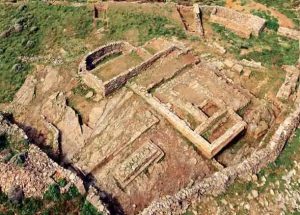
On the steep north-eastern side of the island at Skouries, 20 circular constructions of slates have been discovered which enclose metallurgical furnaces as well as a copper mining mine dating back to around 3,000 BC.
In the Kastella area in the southwestern part of the island and near the Kastella beach, an ancient acropolis has been discovered and the excavation showed that it was founded during the early historical times and was abandoned at the end of the Archaic period.
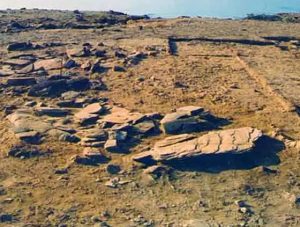
Most likely it was a base or supply station. Here during the excavation about 30 tiled floors were uncovered which belonged to some accommodation. In addition, two semi-subterranean structures were found inside rock cavities. Unfortunately, part of the archaeological site has been destroyed by the erosion suffered by the sea, while the total area is estimated at 2 hectares.
The Castle of Oria is located in the northern part of the island very close to Chora. It was the capital of the island during the Middle Ages from the 7th to the 16th century AD. However, this place seems to have been inhabited since prehistoric times. Today only the ruined walls and some ruined houses can be seen.
Museums
While Kythnos might not have an extensive array of museums like larger islands or urban centers, the few it offers are insightful for visitors keen on understanding the island’s heritage.The museums on Kythnos, though not vast, encapsulate the island’s multifaceted history, from ancient civilizations and religious traditions to local life and economic activities. A visit to these establishments enriches the overall Kythnian experience for tourists, offering them a deeper understanding of the island beyond its natural beauty and serene ambiance.
Folklore Museum in Driopida
Located in the village of Driopida, this museum is a testament to Kythnian daily life and traditions. It’s housed in a traditional building and showcases a collection of everyday items from the past. Visitors can see objects related to farming, fishing, and domestic life. There are also displays of traditional costumes and textiles, which highlight the island’s renowned weaving traditions. Photographs and other memorabilia provide insights into the lifestyles and celebrations of past generations. The museum offers a journey through time, making it an essential stop for those keen on understanding the cultural evolution of Kythnos.
Archaeological Collection in Chora
Though not a large museum, the archaeological collection in Kythnos’s capital, Chora, offers significant insights into the island’s ancient past. The exhibits contain artifacts discovered in various archaeological sites around Kythnos. These range from the prehistoric times of the Cycladic civilization to the Roman era. The collection includes pottery, tools, sculptures, and inscriptions. Each artifact tells a story of the island’s role and evolution in the broader tapestry of Aegean history.
Byzantine Museum
This museum, though smaller in scale, is dedicated to the Byzantine era’s religious and artistic heritage. It houses icons, religious artifacts, and other ecclesiastical items from Byzantine churches on the island. The intricate artistry and deep religious significance of the items offer visitors a look into the spiritual life and artistic endeavors of Kythnos during the Byzantine period.
Mining Museum
Given the historical significance of mining activities on the island, especially in the areas near Merichas, a museum dedicated to this aspect of Kythnos’s history offers insights into the techniques, tools, and stories of miners. While it’s more of a specialized interest, it provides a different perspective on the island’s economic and social past.
What to do
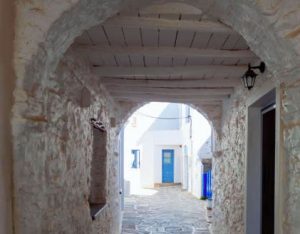
Chances are you’ll be staying in the small port of Merihas where the majority of the island’s small selection of holiday accommodation is centred. It’s not the most attractive spot on Kythnos so head out to the island capital Hora (also know as Messaria), six kilometres north east of the port.
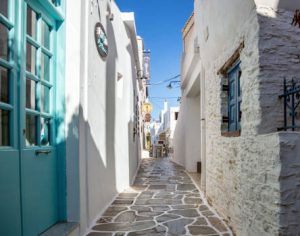
Hora is built around the 17th century churches of Agios Savas, founded by the Venetians, Metamporphosis tou Sotira (Transfiguration of the Saviour) which houses some precious religious icons and Agia Triada (Holy Trinity). The latter is the oldest church on the island – a domed single-aisle basilica with well-preserved frescoes and icons from the post-Byzantine period. Ancient sculptures and inscriptions have been found in the area around the church.
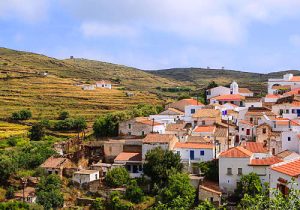
There’s a small folklore museum which opens its doors in high season and a good local ouzeri called O Apithanos.
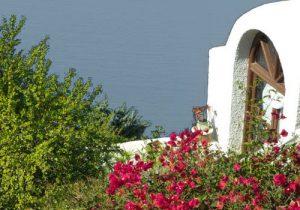
The sole reason why many visitors come to Kythnos is to take the mineral rich waters of Loutra, on the north east coast, which for centuries have attracted those seeking a cure for everything from rheumatism and arthritis to heart and gynaecological problems.
The sulphurous, radioactive thermal springs can reach temperatures of 52C, producing steam from the cool waters of the Aegean Sea. For a few Euros you can have a health check and take the waters at the state-run Xenia baths complex.
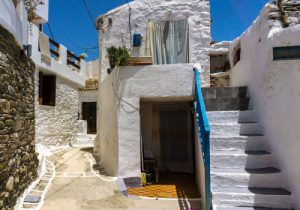
Although the heart of the island beats here, it manages to maintain a traditional character, far from the pretensions which is complemented by the hospitality of the inhabitants!
From here the road continues to Loutra, a fishing village where you will find very nice shops, while it is also worth a stop at the reference point of the whole island, the thermal baths that were built under Othon in 1836! Although you may be discouraged by their old appearance, a thermal bath will offer you moments of relaxation. A must stop is also in Dryopida, a village, where the Cycladic blue is not the star, but the tiled roofs!
Wander through the narrow alleys with the steep stairs and visit the Katafyki cave, to admire the impressive stalactites and stalagmites! Continue south for a walk to Panagia Kanala, a picturesque settlement dominated by the homonymous church and patron saint of the island!
Villages of Kythnos

There are also three main coastal settlements, Loutra in the northern part of the island with a population of 81 people, Merichas the port of the island in the west of Kythnos with population of 369 people and the picturesque settlement of Panagia Kanala in the southeast of the island with a population of 24 people.
Beaches
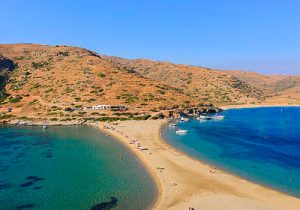
Beaches without wind, beaches with fine sand, beaches with pebbles, secluded beaches, deserted beaches, beaches for families, beaches for children, whatever your swimming preferences are, in Kythnos you will find the ideal beach.
Almost all beaches in Kythnos are accessible by road, although in a few cases the road is dirt, rough and difficult.Kythnos hides some beaches that will surprise you with their pristine beauty (almost all of them are unorganized), although you should be prepared for hard-to-reach dirt roads.
First and best, Kolona (prefer to go by water taxi), where a strip of sand becomes a bridge between Kythnos and the tiny island of Agios Loukas, offering spectacular views!
If you don’t want to bother, prefer Episkopi and Apokrusi, the only organized ones, while if you’re looking for a dose of beach paradise, then you’ll find it on the beach of Skylos. Equally impressive, Agios Sostis, Potamia, Fykiada, Agios Dimitrios, and more!
Hiking in Kythnos
Kythnos has all those characteristics that make it unique and suitable for hiking. Hiking the paths of Kythnos, you will have the opportunity to get in touch with its roots, history, natural beauty and culture.
You will follow unique routes in which you will encounter pristine landscapes, picturesque settlements, unique beaches, archaeological sites, Byzantine monuments, chapels, windmills, rural buildings with stone threshing floors, and many other elements that will leave you with a sweet taste of the island.
The island has a rich network of hiking trails that vary in degree of difficulty due to the relief of the terrain. Some of them are marked.
Local cuisine and products
The local cuisine in Kythnos is almost the same as in the rest of the Cycladic islands and you rely on local local products.Kythnos is an island where most of the inhabitants are mainly engaged in fishing, animal husbandry and in recent years tourism.
The horticultural crops are mostly family vegetable gardens and the produce is used for domestic and local consumption.
Beekeeping is prominent in the primary sector with the majority of beekeepers keeping a small number of hives and aiming to earn a supplementary income. Thermio honey is mostly thyme and is considered excellent in quality with limited production. Therefore, the quality of the products produced in Kythnos (cheese, meat, wine, vegetables, honey) is excellent and their production method is close to organic production methods.
Kythnos, surrounded by the sea, naturally has a wide variety of seafood in its kitchen (sardines, flounder, mullet, mullet, flounder, swordfish and squid) which are prepared in all manner of ways.
Products of the local home-craftsmanship are Thermia sausages, Thermia nuts and Thermia wine, which, together with Thermia cheese, are considered famous in terms of quality and taste, known throughout Greece and abroad.
Where to eat
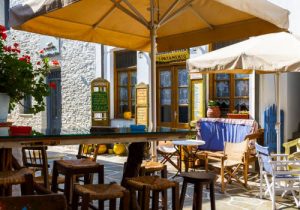
At Archipelagos, in Kanala, for 35 years Eleni’s tavern has been cooking traditional recipes , while at the Messaria restaurant, in Chora, you will grab a table on the roof overlooking the main alley and taste specialties of the local cuisine.
A little further up, Steki tou Detzi will pull you by the nose with its grilled dishes, while fish lovers will find their joy at the Arias restaurant, in the bay of Agia Irini. For a sweet conclusion, go without a second thought to Tratamento in Chora
Nightlife and entertainment
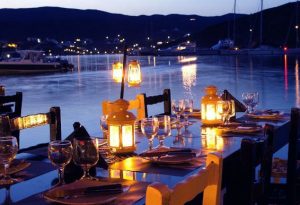
Before your coffee or meal taking a stroll you can enjoy the mills and traditional fountains and arches that adorn the picturesque stone cobblestones painted with beautiful lime designs. Of course you should not forget to take a walk in the shops, where you can buy souvenirs for you and your friends.
The inhabitants of Kythnos are particularly hospitable, perhaps the most hospitable of the Cyclades. Very likely where you will sit you will be treated to some ouzo. What you have to do is taste the local delicacies of the island, such as frygadelia, tyrovoli and kopanisti.
In the evening, get to know the nightlife of Kythnos in the bars, clubs, but also in the taverns with live music. The entertainment will be special until the early hours of the morning. Appetite to have fun.
Where to stay
You won’t find a huge range of hotels on Kythnos as the island is largely overlooked by international tourists. But there are plenty of rooms to let and studio apartments available in high season to cater for the Athenian visitors who come here to take advantage of the curative thermal springs in the north of the island.
Rooms and studio owners often wait at the quayside to greet visitors arriving off the ferries during July and August. If you haven’t booked in advance your best bet is to either check out what these owners have to offer or scout around the waterfront and back streets of the port of Merihas for “rooms to let” signs. The owners may not be on the premises, especially if you’re visiting out of season, but you’ll find their phone numbers advertised in the windows or on the walls outside.
If you don’t fancy trudging around the port in search of accommodation, pop along to Milos Express or Larentzakis Travel who will probably be able to help you.
Good choices include Paradise Rooms at the top of the town – it’s a hard climb up the steps to get to it but you’ll be rewarded with fabulous views of the bay. Panayiota, behind the small bridge on the seafront, offers reasonably priced clean and spacious rooms with 2-3 beds, private bathroom, kitchenette and fridge.
Kythnos Hotel is the only proper hotel in town but you’ll need to book well in advance if you want to stay here in high season. It’s near the ferry dock, up the first set of steps on your way into town. The rooms are fairly basic but comfortable with air conditioning, TV and fridges. The hotel’s rather limited facilities include a downstairs café.
There are plenty of places to stay in the small seaside resort of Loutra, in the north east corner of the island, which has grown up around the famous thermal springs. The increasing interest in alternative medicine brings visitors from far and wide to bathe in the radioactive waters which are rich in iron and sulphur. The waters are widely believed to ease a variety of ailments ranging from rheumatism and arthritis to heart and gynaecological problems.
You can stay in the state-run Xenia baths complex and have a soak in the springs together with a basic health check (heart rate, blood pressure and weight).
The well-equipped Kythnos Bay Hotel in Loutra is just 30 metres from the beach and 300 metres from the springs. All rooms have a fridge, TV, air conditioning and private balcony with either sea or mountain views. The hotel has a restaurant, a beachside taverna serving traditional Greek food, a spacious lounge and indoor and outdoor bars.
One of the most upmarket places to stay is the Porto Klaras Hotel which offers 20 studios and apartments a few metres from the beach at Loutra. The hotel has been built in the traditional Cycladic style and has wonderful panoramic views of the bay. All rooms have a private bathroom, fridge, TV, telephone and a veranda.
You can sometimes find rooms to rent in the picturesque inland town of Dryopida, especially in high season when islanders open their homes to visitors.
Kanala, in the south east corner of the island, has a small selection of pensions and studio apartments and you can also find rooms to rent around the double bay of Agio Dimitriou in the south west during the summer months.
Weather in Kythnos
Kythnos is one of the driest regions of Greece with an average annual rainfall below 400 mm. These small amounts of rain are due to both dynamic and geographical factors. It is noted that the mountain ranges of the Peloponnese and Crete prevent rain-bearing winds from reaching most of the Cyclades islands.
The average monthly rainfall is 30.39 mm, while the total annual rainfall is 364.70 mm. The driest months are July and August (0.1 days) and the wettest (rainiest) is February (6.7 days). Snowfall occurs during January and March.
The average number of days with snowfall during the year is 0.6 days. Hail is relatively rare, while thunderstorms occur more often.
In Kythnos, northerly winds prevail, while in the summer season the well-known meltemia cools the atmosphere. The winds of the Aegean that appear during the warm months, i.e. from May to September, are northerly winds and are called annual or meltemia.
Normally the review period starts around the end of May and ends around the end of October. The months of July and August have the greatest intensity and an average duration of 2 to 4 days, without presenting the same frequency every year.
These winds blow mainly during the day from 8 in the morning until 8 in the evening and acquire their greatest intensity around 2 in the afternoon.
They are characterized by fluctuations, while they quickly fade after sunset and return at dawn.
In the N. Aegean it is N.E. winds, in the Central Aegean they become North and in the South Aegean N.W. With the influence of the sea breeze during the day, meltemias increase locally. The greatest intensity of melting occurs in the S. Aegean and especially in the Cyclades region. In the winter in Kythnos, the north winds of the Aegean blow, reaching up to 8-9 Beaufort.
Local transport
Although the island is small. surely your own means of transport will give you freedom of movement to get around and go to places not served by local transport.
On the island there are two bus lines that serve local transportation. One bus line serves the northern part of the island running the route Mericha-Chora Kythnos-Loutras and the other bus line runs the route Merichas-Dryopida-Panagia Kanala Kythnos.
For the local transportation needs of the island there are also several Taxis. In the port of the island and in Loutra there are rental companies for both cars and two-wheelers. For information and phone numbers click here.
The island is covered by two main roads. The first road axis starts from the port of the island of Mericha and serves the northern part of the island and the second serves the South-Eastern and southern part of the island with several branches. In recent years, a new provincial road was put into use that connects the two largest villages with each other, Dryopida and Chora, shortening the route a lot.
How to get there
By ferry
Access to Kythnos can be done by Ferry from the port of Piraeus and from the port of Lavrio which run daily routes. From the port of Piraeus, the distance between the two ports is approximately 52 nm and the duration of the trip made with modern ships is approximately three hours.
From the port of Lavrio, the nautical distance between the two ports is approximately 25 nm and the journey takes less than two hours. Even in both the summer and winter months there is transport coverage of the island with most of the Cycladic islands.
By Air
There is no Airport in Kythnos and the only aerial approach to the island is by helicopter.The island’s heliport is located at a very short distance from the settlement of the country and serves mainly private helicopter rental companies that operate flights to transport financially well-off visitors to Kythnos as well as for emergencies concerning the air transport of patients to the hospital of Syros and also to Hospitals in Athens. And for the needs of visitors who want to move to the island with their own watercraft, there are several moorings as well as two marinas.
